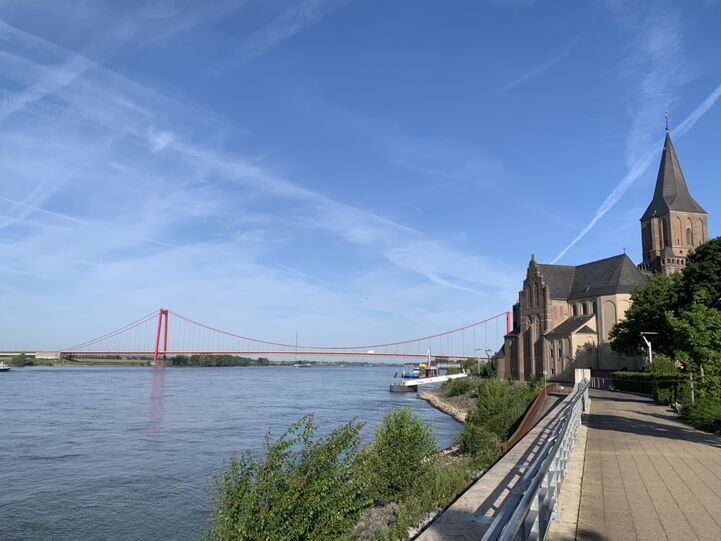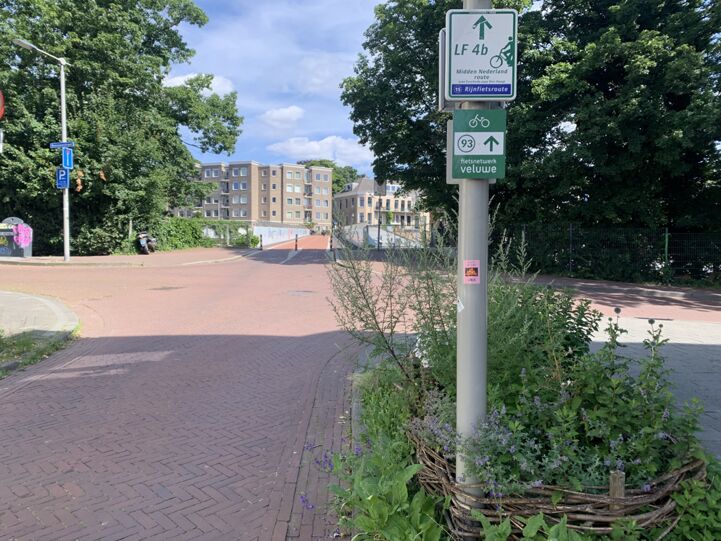900 km in 6 Tagen: ein (fast) Ausdauer-Radabenteuer auf dem EuroVelo 15 – Rheinradweg
Im Juni 2024 habe ich mir einen Traum erfüllt. Ich bin mit dem Fahrrad den EuroVelo 15 entlanggefahren, der in Andermatt in den Schweizer Alpen beginnt und sich auf über 1.500 Kilometer durch sechs Länder erstreckt. Meine Reise führte mich entlang des Rheins von meiner Heimatstadt in Deutschland bis nach Hoek van Holland. Ich startete an einem Dienstag und hatte bereits für Sonntagabend ein Busticket mit Fahrradtransport von Rotterdam nach Stuttgart gebucht. Das bedeutete, dass ich in sechs Tagen fast 900 Kilometer mit dem Fahrrad zurücklegen musste. Angesichts der hohen Temperaturen und der langen Tageslichtstunden entschied ich mich, mit meinem Zelt zu reisen, um unabhängiger zu sein und im schlimmsten Fall an einem beliebigen Ort entlang der Strecke in der Natur schlafen zu können.

Am ersten Morgen startete ich um 5 Uhr morgens. Es wurde bereits hell, und die Farben des frühen Sonnenaufgangs begannen, den Himmel zu färben. Es war ein tolles Gefühl, wieder mit meinem Fahrrad verbunden zu sein, das zusätzliche Gewicht des Gepäcks zu spüren und zu wissen, dass EuroVelo 15 – Rheinradweg mein Begleiter für diese Woche sein würde. An diesem Tag fand ich um 14 Uhr einen schönen Campingplatz und stellte nach einem Blick auf meine Navigations-App fest, dass ich bereits 148 Kilometer zurückgelegt hatte. Die Hitze war enorm: Ich muss fünf oder sechs Liter Wasser getrunken haben und hatte trotzdem noch leichte Kopfschmerzen. Am nächsten Tag spürte ich, dass meine Muskeln nicht mehr weitermachen wollten. Aber die Sehnsucht nach Hoek van Holland war stärker, also fuhr ich weiter in Richtung Heidelberg, Mannheim und Rhein. Die Fahrt entlang dieses Flusses war fantastisch, da mir viele Erinnerungen in den Sinn kamen. Als Teenager war ich mit meinem Vater nach Düsseldorf geradelt, und im Januar 2023 fuhr ich bei kalten Temperaturen und Schnee alleine von Weil am Rhein nach Mainz. Diesmal war der Wasserstand aufgrund der starken Regenfälle in den Wochen zuvor ziemlich hoch. Aber als ich dort durchfuhr, war es eigentlich der perfekte Moment: Die Gebiete, die normalerweise überflutet sind, waren jetzt problemlos zu durchqueren. Dennoch war die Zahl der Menschen, die diese Route nutzten, nicht hoch, wahrscheinlich wegen der jüngsten Stürme. Ein Highlight dieses Tages war die Theodor-Heuss-Brücke, die den Fluss überquert. In der Mitte einer vierspurigen Autobahn befindet sich ein Durchgang für Radfahrer und Fußgänger, aber es ist immer noch schwierig, ein beladenes Fahrrad die Treppen hinauf und hinunter zu tragen. Leider war die Beschilderung an Baustellen zweimal schlecht, und ich musste einige Umwege fahren. Die folgende Passage war wunderschön. Die Landschaft wurde immer spektakulärer, und die Radwege waren größtenteils separat angelegt und in gutem Zustand. Zu den unvergesslichsten Momenten der folgenden Tage gehörten Bingen im UNESCO Welterbe Oberes Mittelrheintal, in dem 2029 die Bundesgartenschau (eine nationale Gartenbau- und Kulturveranstaltung) stattfinden wird, die Gedichte von Lord Byron, die malerische Stadt Bacharach sowie die Nachahmung der Reise von William Turner in umgekehrter Richtung von Koblenz nach Bingen im Jahr 1817.

In Nordrhein-Westfalen führte mich eine perfekte Beschilderung bald nach Bonn, Köln, Leverkusen, Düsseldorf und Duisburg. Ich konnte zum ersten Mal die Niederlande vom Fahrrad aus riechen und mir wurde klar, dass ich es wahrscheinlich pünktlich zur Nordsee schaffen würde. Nach Sonnenuntergang und 235 Kilometern in den Beinen schlug ich mein Zelt in der Nähe des Rheins auf, neben einer Gruppe osteuropäischer Fischer, um mich sicherer zu fühlen. Es war eine friedliche Atmosphäre für den bisher längsten Tag auf meinem Fahrrad.

Am nächsten Morgen setzte ich mich auf die erste schöne Bank in den Niederlanden, genoss mein Frühstück und war glücklich, endlich im Land des Radfahrens angekommen zu sein. Nur wenige Tage zuvor hatte ich zu Hause einen Online-Kurs namens „Unravelling the Cycling City” (Die Fahrradstadt entschlüsseln) des Urban Cycling Institute mit Sitz in Amsterdam abgeschlossen. Daher wusste ich um die Privilegien der Niederländer in Bezug auf ihre Infrastruktur und ihr kulturelles Verständnis. Kilometerlange rote separate Radwege, ein Fahrradlift neben Treppen, gut gestaltete sichere Kreuzungen, Ampeln, die den sogenannten „Fietser” empfehlen, langsamer zu fahren, um die nächste grüne Ampel zu erwischen, ohne anzuhalten – ich war im Himmel.
Die Infrastruktur erfüllte die Anforderungen der verschiedenen Verkehrsmittel ohne größere Probleme. Dennoch gab es auch einige Nachteile, mit denen ich nicht gerechnet hatte. Da es teilweise so viele Radwege gibt, war ich verwirrt, welcher der richtige war, ohne in alle kleinen Stadtzentren geführt zu werden. Ich musste vorsichtig fahren, da die Autofahrer auf dem Deich an einigen Stellen schnell und rücksichtslos fuhren. Nach Arnheim verpasste ich einige offizielle EuroVelo-Schilder und folgte meiner Navigations-App unter schwarzen Wolken in Richtung Schoonhoven. Ich lag trocken in meinem Zelt, hörte die Regentropfen fallen und aß typisch holländisches Brot mit viel Erdnussbutter, Bananen und Stroopwafels. Ich schaute mir die Postkarte an, die mir mein Vater aus Rotterdam geschickt hatte und die die ikonische Skyline mit dem Stadtteil Zuid und der Erasmusbrücke zeigte, und träumte davon, diese Stadt am nächsten Tag mit dem Fahrrad zu erreichen.

Am Sonntag wurde dieses Bild Wirklichkeit, als ich am „Manhattan Europas“ vorbeifuhr, wohl wissend, dass ich nach Hoek van Holland in die zweitgrößte Stadt des Landes zurückkehren würde. Auf den letzten 40 Kilometern wurde der Gegenwind stärker, der Kilometerzähler des Flusses zeigte 1015 an, und die Windkraftanlagen liefen auf Hochtouren. Europas größter Seehafen, der Hafen von Rotterdam, lag auf der anderen Seite des Wassers. Nachdem ich einfach nur auf dem Pier vor der Nordsee gestanden und die Aussicht und die Energie genossen hatte, wurde ich schließlich mit meinem „Bleu de Marseille“-Shirt und dem Stahlfahrrad fotografiert. Im Touristenzentrum in Hoek van Holland erhielt ich ein signiertes EuroVelo 15 – Rheinradweg-Zertifikat mit einem Foto und konnte mich nun offiziell als „Fietser”, „Radfahrer”, „Cyclist” und „Cycliste” bezeichnen. Ohne Hindernisse stellte ich mein Fahrrad in die Metro, kehrte nach Rotterdam zurück, nutzte den unglaublichen Fahrradtunnel und wartete im Stadtteil Zuid auf den Bus.
Als ich von meinem Sitzplatz aus in den Nachthimmel blickte und die Regentropfen am Fenster beobachtete, wurde mir klar, dass ich nicht nur den EuroVelo 15 – Rheinradweg befahren hatte, sondern auch die europäischen Fernwanderwege E1, E3, E8 und E9 sowie die Nightjet-Zugstrecken überquert hatte. Hundertdreiundfünfzig Stunden nachdem ich mein Zuhause verlassen hatte, kehrte ich zurück, mit 896,51 Kilometern mehr auf meinem Kilometerzähler – das entspricht der Länge des E10, der Via Lemovicensis oder der Underground Railroad Bicycle Route (UGRR) Detroit Alternate – und 250.000 Pedalschlägen in meinen Beinen. Ich weiß, dass Paris, Brüssel und London bald folgen werden.

Über den Autor:
Julian Herzel liebt Reisen, Schreiben und Radfahren. Der Stadtplaner hat bereits 40 Länder besucht und ist in 23 davon mit dem Fahrrad unterwegs gewesen. Er erinnert sich gerne daran, wie er an einem autofreien Sonntag an der Ciclovía in Bogotá teilgenommen und mit dem Fahrrad die Küsten des Schwarzen Meeres, des Atlantiks, der Nordsee oder des Mittelmeers erreicht hat. Die Verfügbarkeit von Fahrradverleihstationen und geschützten Radwegen in Städten wie Kairo und Mexiko-Stadt inspiriert ihn. Lesen Sie in seinem letzten Artikel mehr über sein Winter-Radabenteuer. Weitere Informationen über die Reise und GPS-Tracks der Etappen finden Sie auf seiner Website.